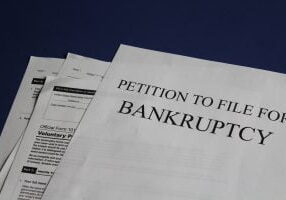Aftermath of COVID-19: Importance of Understanding Insolvency with the Expected Rise in Bankruptcy Filings
The economic slowdowns resulting from COVID-19 will no doubt cause an increase in bankruptcy filings. Despite the sad reality, understanding a company’s insolvency is critical in the bankruptcy proceedings. Whether you are the debtor or a creditor, determining insolvency and its timing is important.
According to U.S. Code Section 101.32(A), insolvency generally means a “financial condition such that the sum of such entity’s debts is greater than all of such entity’s property, at a fair valuation.”[1] The standard of value is what they call “fair value,” however this is not a well-defined term in the bankruptcy code. Based on our experience, fair value generally means “fair market value,” which is a standard that is used frequently in many types of valuations that are non-insolvency related matters. Fair market value is defined as: “the price at which property would change hands between a hypothetical willing and able buyer and a hypothetical willing and able seller, acting at arms-length in an open and unrestricted market, when neither is under compulsion to buy or sell and when both have reasonable knowledge of the relevant facts”. When determining insolvency, it is important to distinguish the difference between book value and fair market value.
There are three tests or methods to determine insolvency of a company. Those three methods are
1) the balance sheet test,
2) the cash flow test and
3) the capital adequacy test.
Each of these methods is discussed in greater detail below.
Balance Sheet Test
The distressed company’s balance sheet will include the book values of the assets and liabilities. The historical book values of these assets do not necessarily represent the fair market value, and accordingly, adjustments need to be made. These adjustments could include a valuation of inventory that may be obsolete or may adjust the values for fixed assets that have excessive wear and tear. There may also be assets or liabilities that are not recorded on the  balance sheet that need to be considered, such as profits from future projects (i.e. the company’s backlog) or some of the company’s intellectual property. In addition, an example of an unrecorded liability might be future operating lease payments. This would represent a contingent liability.
balance sheet that need to be considered, such as profits from future projects (i.e. the company’s backlog) or some of the company’s intellectual property. In addition, an example of an unrecorded liability might be future operating lease payments. This would represent a contingent liability.
The example shown here indicates that the company is solvent when looking only at its net book value (total assets minus total liabilities). When determining the fair market value of its assets and liabilities, it is clear that the company’s liabilities outweigh the company’s assets making this company insolvent.[2]
Cash Flow Test
The cash flow test looks at the distressed company’s net cash flows and determines whether incoming cash flows exceed mandatory cash outlays. For example, if a company has annual positive net cash flow of $1 million a year, and they have mortgage payments of $800,000 a year, then they are solvent because net cash flows are greater than the debt service payments.
In reality, the analysis is more complex than this. There are various adjustments that need to be made to revenues, expenses and profits to result in the net cash flow for the business. Non-cash transactions such as depreciation and amortization should be adjusted to the profits and cash flow amounts. Capital expenditures and changes in working capital should also be considered when determining cash flow for a particular period.
The cash flow test analysis reviews the company’s historical net cash flow and projects incoming cash flow in future years and estimates what future cash outlays would be. The example shown here illustrates the cash flow test in comparing incoming cash flows to mandatory cash outlays such as debt-service. Our analysis includes a look at historical years as well as what our expectation of cash flow would be in the future. 
In addition, the analysis can include a review of market and trends. The analysis may compare the results with other market participants to see what their results are and whether the debtor is greater or less than the competitors. Depending on whether or not the market participants are higher or lower than the subject company can have an impact on the results of the cash flow test.
In the illustration here, the distressed company does not expect to cover its debt service over the 3-month period. Despite adjusting profits and cash flow, the adjustments, along with its profits are not enough to cover the distressed company’s net cash flow, rendering the company insolvent. While this is a simple example, similar analysis is done for more complex, real-world situations.
Capital Adequacy Test
The capital adequacy test has a lot of similarities of the balance sheet test and the cash flow test. What this test tries to prove is whether there is enough capital in the business to keep the business a going concern for future years. This test also considers the availability of additional financing and whether the distressed company has assets to collateralize for additional financing.
The capital adequacy test commonly uses a ratio approach to determine whether there is enough capital or the ability to get capital in a company to remain solvent. Part of this test includes calculating various coverage and liquidity ratios and comparing these ratios to competitors and industry averages.
In the example here, the ratio analysis is performed with the historical and projected financial statements of the business. There is a decrease in the ratios which may indicate the company is insolvent. These ratios indicate whether the company has enough capital in the business to keep operating, if it can obtain financing or if the working capital is sufficient enough each year to sustain the operations of the business. In this case, it appears there is not enough capital, but there are certainly more factors to consider than what is presented here.
Summary
With any test, there is more to it than meets the eye, but the point is, a number of these ratios coupled with some additional analysis that we might perform would indicate whether or not the debtor is solvent. There are a number of documents that an expert would need to perform their analysis including but not limited to: accounting records, tax returns, internal work schedules and debt-related schedules/agreements. A qualified expert can help determine solvency and work with the business owner or their representatives in getting through these difficult times.
_______
[1] Note that there are different definitions for partnerships, business entities and municipalities but they generally all refer to the idea of debts outweighing total assets.
[2] For those readers who are familiar with business valuation methods, this method is similar to the asset/cost approach method.
The contents above are purely educational in nature. The information contained within the website of Vallit Advisors, LLC should not be assumed to be representative of the views and opinions held by Vallit Advisors, LLC. Information found on this website is not intended to be legal advice, it is not intended to create or solicit instructions of any kind and should not be treated as such. By accessing this web site, you are agreeing to be bound by the web site Terms and Conditions of Use.
Providing a Clear View of The Financial Picture
Vallit is focused solely on dispute consulting, business valuation and forensic accounting. Our senior team members have testified over 200 times in Federal, State and International courts. Our dispute expertise ranges from family law to complex commercial and intellectual property matters in a wide variety of industries. In non-disputes, our valuation reports are relied on by estate and trust attorneys, auditors, and business decision makers for tax, financial reporting and transaction purposes.




















